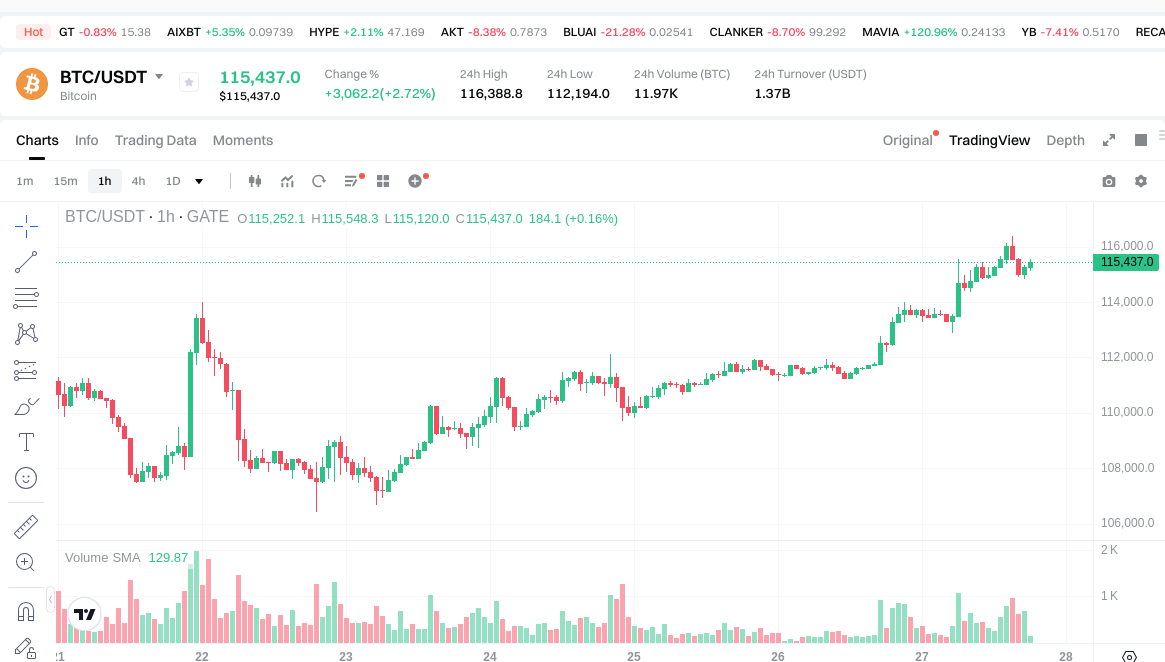Bitcoin Hakimiyetini Anlamak: Ayrıntılı Bir Rehber


Bitcoin Hakimiyeti: BTC.D Detaylı Açıklama
Bitcoin hakimiyeti (BTC.D), Bitcoin’in toplam piyasa değerindeki payını ölçen ve kripto para piyasasında büyük öneme sahip bir göstergedir. Bu makalede, Bitcoin hakimiyeti kavramı, bunun piyasadaki etkileri ve yatırımcılar ile traderlar açısından taşıdığı önem ele alınmaktadır.

Bitcoin Hakimiyeti Nedir?
Bitcoin hakimiyeti, kısaca BTC.D olarak bilinir, Bitcoin’in toplam kripto para piyasası değerindeki yüzdesini gösterir. Bu oran, Bitcoin’in piyasa değeri tüm kripto paraların toplam piyasa değerine bölünerek hesaplanır. Böylelikle, yatırımcılar Bitcoin’in diğer kripto paralara göre göreceli gücünü net biçimde görebilir.
Bitcoin hakimiyeti, piyasa koşullarına bağlı olarak değişkenlik gösterir. Hakimiyet arttığında, piyasanın Bitcoin’e yöneldiği daha temkinli bir yaklaşım öne çıkar. Hakimiyet azaldığında ise, altcoinlere artan ilgiyle birlikte hareketli dönemler yaşanabilir.
Bitcoin Hakimiyet Grafiği (BTC.D) Nedir?
Bitcoin Hakimiyet Grafiği (BTC.D), Bitcoin’in piyasadaki payının zaman içindeki değişimini görsel olarak sunan teknik bir analiz aracıdır. Bu grafik, Bitcoin’in kripto piyasasındaki yüzdesini göstererek traderların piyasa eğilimlerini ve değişimlerini izlemelerine olanak tanır. Grafik; farklı zaman dilimleri ve Bitcoin ile diğer kripto paralar arasındaki ters ilişki gibi analiz parametrelerini de içerir.
Bitcoin Hakimiyet Grafiği Nasıl Okunur?
BTC.D grafiğini analiz etmek, piyasa döngüleri ve genel piyasa psikolojisi hakkında önemli bilgiler sunar. Yüksek hakimiyet, Bitcoin’in öncülüğünde bir piyasa veya altcoinlerden sermaye çıkışı anlamına gelirken; düşük hakimiyet, artan risk iştahı ve alternatif dijital varlıkların öne çıkması anlamına gelir. Grafikteki ani değişimler, büyük piyasa hareketlerinin öncesinde ya da sonrasında önemli bir gösterge olabilir.
BTC.D’nin Diğer Kripto Para Fiyatlarına Etkisi
Bitcoin hakimiyeti, diğer kripto paraların fiyat performansı üzerinde doğrudan etkilidir. Örneğin, BTC.D yükselirken ve Bitcoin fiyatı artıyorsa, diğer kripto paralar genellikle ya değer kaybeder ya da Bitcoin’e kıyasla daha az yükselir. Tersine, BTC.D düşerken ve Bitcoin fiyatı artıyorsa, diğer kripto paralar çoğunlukla Bitcoin’den daha fazla değer kazanır. Bu ilişkileri doğru anlamak, traderların daha doğru stratejiler geliştirmesini sağlar.
Bitcoin Hakimiyeti Kripto Alım Satım Stratejiniz İçin Neden Önemlidir?
Bitcoin hakimiyeti, kripto alım satım stratejilerinin geliştirilmesinde önemli bir analiz aracıdır. Piyasadaki risk algısını anlamayı sağlar, altcoinlere giriş zamanlamasına yardımcı olur, piyasa döngüsündeki pozisyonu tespit etmeye katkı sunar, portföy çeşitlendirmesine dair sinyaller verir ve çıkış noktalarını belirlemede kullanılabilir. BTC.D’yi analizlerine dahil eden traderlar, portföylerini piyasa trendlerine daha etkin şekilde uyarlayabilir.
Bitcoin Hakimiyet Grafiğinin Sınırlamaları
BTC.D grafiği kullanışlı olsa da bazı kısıtlamalara sahiptir. Piyasa değeri manipülasyonunu yansıtmaz, işlem hacmini göz ardı eder, stabilcoinlerin piyasadaki etkisini hesaba katmaz ve aşırı piyasa koşullarında anlamını yitirebilir. En iyi sonuç, bu grafik diğer analiz araçlarıyla birlikte kullanıldığında alınır.
Sonuç
Bitcoin hakimiyeti, kripto para piyasasının dinamiklerini anlamada güçlü bir gösterge sunar. BTC.D’yi doğru analiz eden yatırımcı ve traderlar, portföyleriyle ilgili daha bilinçli kararlar alabilir. Ancak, bu göstergenin sınırlamalarının farkında olmak ve yalnızca buna dayanmak yerine kapsamlı analiz yaklaşımıyla birlikte kullanmak gerekir. Kripto piyasasının sürekli değişen yapısında, Bitcoin hakimiyeti gibi metrikler hakkında güncel bilgi sahibi olmak başarı için kritik önemdedir.
SSS
Bitcoin hakimiyeti (BTC.D) nedir?
Bitcoin hakimiyeti, Bitcoin’in toplam kripto para piyasası değerindeki payını ölçen; Bitcoin’in piyasa değeri, tüm kripto paraların toplam piyasa değerine bölünerek elde edilen bir göstergedir.
Bitcoin hakimiyeti diğer kripto para fiyatlarını nasıl etkiler?
BTC.D yükseldiğinde ve Bitcoin fiyatı arttığında, diğer kripto paralar genellikle ya değer kaybeder ya da Bitcoin’e göre daha az yükselir. BTC.D düştüğünde ve Bitcoin fiyatı artıyorsa, diğer kripto paralar çoğunlukla Bitcoin’den daha fazla yükseliş gösterir.
Bitcoin Hakimiyet Grafiğinin sınırlamaları nelerdir?
BTC.D grafiği piyasa değeri manipülasyonunu yansıtmaz, işlem hacmini dikkate almaz, stabilcoin etkisini içermez ve aşırı piyasa koşullarında anlamını kaybedebilir. En verimli sonucu almak için başka analiz araçlarıyla birlikte değerlendirilmelidir.

Bitcoin Hakimiyeti, Kripto Para Piyasası Trendlerinde Değişimin Habercisi

Kripto para fiyatlarındaki dalgalanma, geleneksel piyasalarla nasıl karşılaştırılır?

Kripto paraların fiyat dalgalanması, geleneksel piyasalarla karşılaştırıldığında nasıl bir tablo ortaya koyar?

2025 Yılında Bitcoin'in Fiyat Dalgalanması Nasıl Bir Gelişim Gösterdi?

PENGU Fiyat Analizi: Volatilite Modelleri, $0.0087 Desteği ve BTC Korelasyonu

Hareket (MOVE) Fiyat Analizi: 2025'te BTC ve ETH ile Volatilite Karşılaştırması

Dropee Günlük Kombinasyonu 12 Aralık 2025

Tomarket Günlük Kombinasyonu 12 Aralık 2025

SEI Airdrop Ödülleri’ne Katılım ve Talep Etme Kılavuzu

Kripto para birimlerinde algoritmik alım satım için etkili stratejiler

Stock-to-Flow Model ile Bitcoin'in Değerlemesini Anlamak





